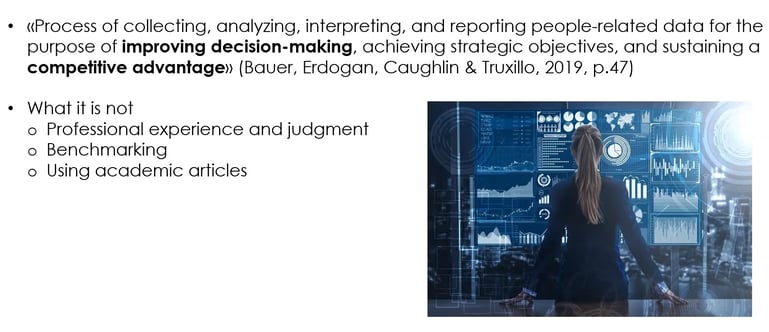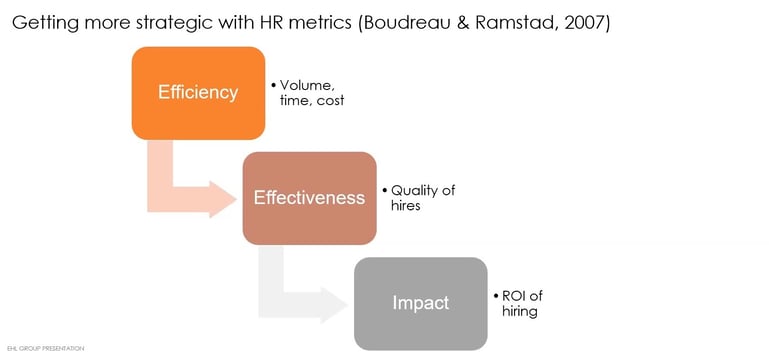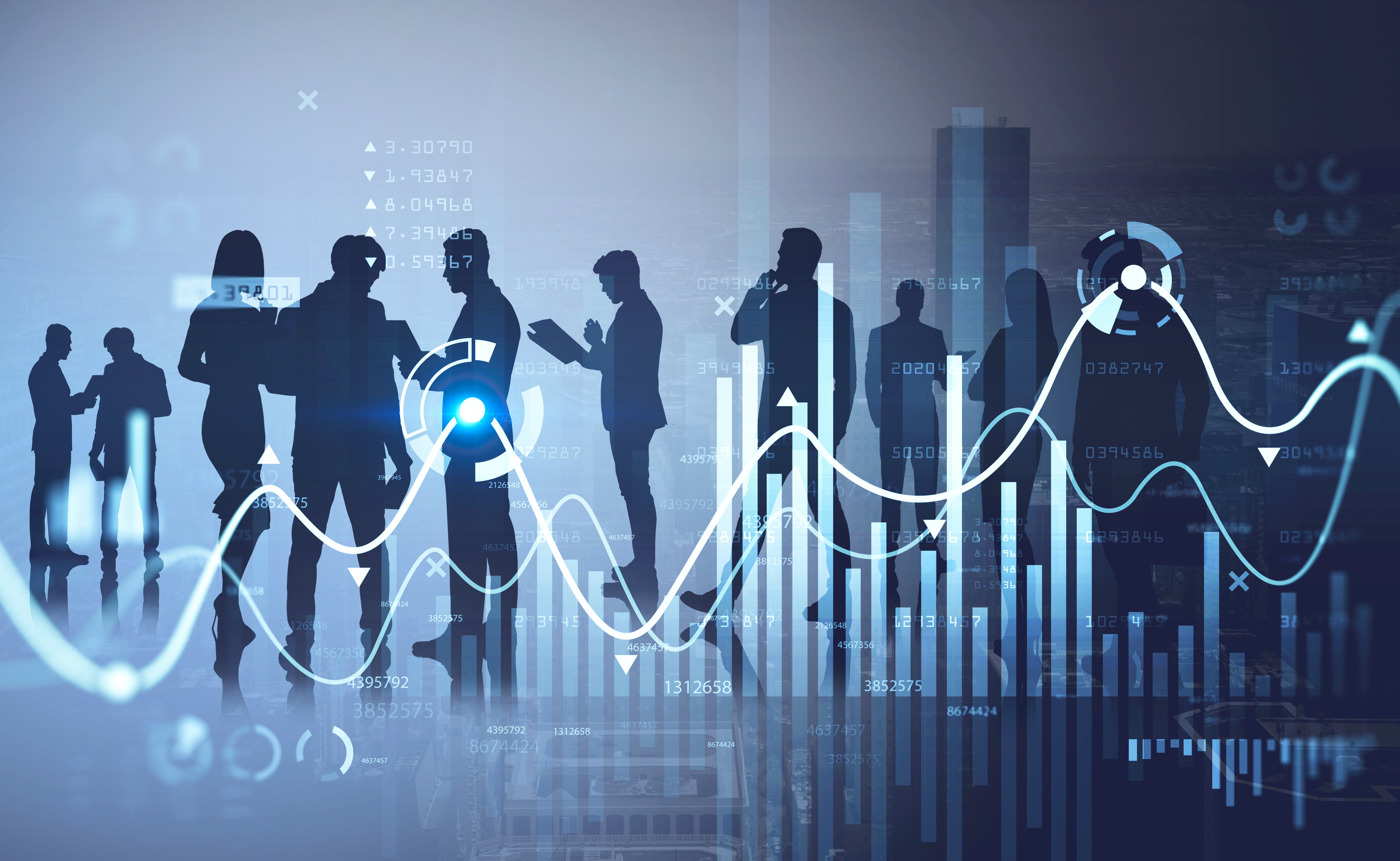For many of us hoteliers who have long been inculcated with a firm belief in the value of the ‘human touch’, the term people analytics may very well come across as a giant paradox – how can cold, hard numbers be used to dissect and analyse the most intangible and invaluable aspect of our industry: our people?
In an EHL webinar, Dr. Sébastien Fernandez, Associate Professor at EHL, Andrew Newmark, Vice President of Human Resources, APEC at Marriott International, and Dr. Michael Fung, Deputy Chief Executive at SkillsFuture Singapore, explained exactly why people analytics is necessary, not only in the hospitality industry, but in the wider realm of talent or workforce management. Representing three different perspectives: the academic, industry, and national viewpoints, they each painted a strong message on why and how data can drive people-based decisions.
Defining: What is people analytics?
Scientifically speaking, people analytics is “the process of collecting, analysing, interpreting, and reporting people-related data to improve decision-making, achieve strategic objectives, and sustain a competitive advantage” (Bauer, Erdogan, Caughlin & Truxillo, 2019). In other words, people analytics is about using data to drive strategic long-term decisions, especially in this technology-based, yet human touch-focused world in which we live today. And the increasing importance of people analytics has not gone unnoticed – companies like Marriott International and countries like Singapore have already been actively investing into people analytics functions to drive decisions.
Get a more detailed definition of people analytics here.

What is ‘People Analytics’? Bauer, T. N., Erdogan, B., Caughlin, D. E., & Truxillo, D. M. (2019).
Human resource management: People, data, and analytics. Thousand Oaks, CA: Sage.
Understanding: Why invest in people analytics?
Every company has its unique set of qualities that they seek in their employees and accordingly devise their own ways of identifying their potential star employees – in which data can play a key role. In an interesting example from the famed employer Google, Sébastien pointed out that, “[Google] processes a lot of data, so they sometimes have six or seven different interviews and through regression analyses, they observed that having a second interview improved the prediction of the future performance of an employee. And with a third one, improved it even more. The fourth one, even better -- but then, they observed that entering a fifth interview adds no predictable value. They saw that and said, ‘Okay, four interviews are enough.’ So that is a good example of how data answers the very basic question of HR processes.”
From a hotel company perspective, people analytics can be useful in measuring how talent management translates into results for the business. “For example [at Marriott],” Andrew began explaining, “our focus may be on the engagement of our associates – but then we look at linking that engagement [rate] to our guest satisfaction scores or other key measures. […] This helps us to identify best practices and support our hotels where engagement [and guest satisfaction] may not be as strong [as our top-performing hotels].” In other words, data is crucial in understanding whether we are managing our people right – and if not, how is that affecting the business and how can we change that?
On a larger scale, people analytics can also be vital in ensuring healthy long-term prospects for a country’s economy. As Michael described, “Technology, the impact of longer lifespans, globalization, pandemics – these are all disruptions that change the nature of work and hence, the skills that need to go with it. Using different people analytics tools can [help us] attempt to assess the stock and flow of skills within the labour market, to identify the emerging skills that will be needed and to design policy interventions to address any gaps. […] This is critical in ensuring that our workforce remains competitive and relevant, and that we don’t face structural problems with skills mismatch in the economy”.
Applying: How to Win with People Analytics?
Strategic decision-making is a highly iterative process – we first need to implement decisions, measure their results and thereafter continuously improve on them. Of the three metrics for measuring the strength of our strategic decisions proposed by Boudreau & Ramstad (2007), “the best angle is the impact,” Sébastien suggested: “To what extent does using this process impact the company? […] Perhaps using a costly procedure like an assessment centre could help us find good leaders who will impact the company positively.” In other words, data can be used to analyse and pinpoint the appropriate trade-offs we should be making, by measuring the impact of our strategic decisions.

Metrics for measuring strategic decisions. Boudreau, J. W., & Ramstad, P. M. (2007).
Beyond HR : The new science of human capital. Cambridge, MA: Harvard Business Press.
In fact, as Andrew explained that at Marriott, “We once went into [an incentive plan] thinking that high performers were being rewarded. But when we looked at the analysis of the plan and pay-outs, we noticed that the ‘high performers’ were achieving their goals because they were quite conservative in their goal-setting, whereas the ‘low performers’ were setting very ambitious goals and not achieving them, but they were actually bringing in more results for the business – yet they were not being rewarded.” Through proper data collection and interpretation, companies can therefore measure the impact of their decisions on their people and the business, and use such insights to improve and optimize their employees and profits.
From a more macro-level viewpoint, people-related data is key in elevating the performance of a country’s workforce. In Singapore, extensive data is gathered to build a repository of skills that the economy needs within each industry and job function – and how the workforce can be trained to fill these needs. “The whole idea is that we would use this information to guide individuals looking to upskill […] and companies who are looking to build up various types of capabilities and functions. Training providers can similarly use the insights to understand what kind of skills are in demand and adjust their offerings accordingly. For policy makers, we would also then introduce interventions that are targeted at bridging these skills gaps,” Michael explained. Workforce analytics can thus be leveraged by multiple stakeholders to continuously keep pace with changing landscapes and ensure that an economy and its people remain competitive.
The power of data and how it can be used to support people
Talent management in the hospitality industry may at times be particularly challenging, given the diversity of backgrounds and needs of people who work in this sector. And as hospitality workers bore the brunt of the COVID-19 crisis, caring for their psychological welfare only became tougher for employers. At Marriott, however, Andrew described how they were able to gather and use data to support their employees, through a resiliency assessment: “What we found was, overall, these associates and leaders were resilient – but they still needed more support from us. There were also differences in needs based on demographics, [type of positions, gender etc.], which helped us to target where we needed to do more or different work [to further support them].”
From the perspective of a country, data can be used to support workers in a different way: “A number of hotels here [in Singapore] had to retrench workers [due to COVID-19]. Now, the question is, how do we identify the skill sets of these retrenched workers to move them into jobs where they have similar or adjacent skill sets? So, using the repository and data that we have, we were able to analyse the kinds of jobs that they could move into, based on the types of job functions of these displaced workers,” Michael explained.
At the same time, the impact of COVID-19 was not limited to the hospitality industry – and as a nation, Singapore was also proactive in identifying the needs and challenges of other sectors. As Michael continued, “We also looked at the sectors where there was growth in demand. [For example,] in health care, e-commerce, security services and cleaning, there was growth. How do we then use that data and information to do [talent] matching? It's not perfect. There are still a lot of human factors involved, but it gave us the right direction to move in as we looked at these interventions in dealing with the COVID pandemic.”
Data as an enabler: Enhancing, not replacing human judgment
Despite the possibilities that power of people analytics holds, however, it is important to recognize that there is still a strong human aspect in managing talent. “We would never simply [hire a general manager based on] an assessment,” Andrew emphasized, “[Analytics] doesn’t replace the conversations, because we need to be able to bring in the insights of the stakeholders [to make a decision. […] Data is the conversation starter, but you want to bring in the expertise from around the table to guide the decision.”
Similarly, in Singapore, “When we look at skills mismatch, it’s not just about this point in time – but also the possible mismatches that might come. There’s a lot of talk about technology and AI replacing routine job tasks. That’s going to affect our workforce as well and so, we have to plan ahead from that perspective. Having data to inform some of those conversations is critical. [But] it's not everything. There still needs to be some degree of judgment about how the economy's going to shape up, how the global trends will impact Singapore in terms of its economy, its workforce, and its companies,” Michael added.
In other words, whether from a business or country’s perspective, data may be crucial in shaping our strategic decisions – however, it is not the be-all and end-all. Data is a tool for humans to enhance, not replace human judgment, and we should continue embracing using data to drive more effective, human decision-making.
Upskilling and multiskilling for a post-COVID world
COVID-19 has accelerated many trends in the work environment, including a higher adaptability of the workforce and greater ease with remote working and using technology. Looking ahead, “I think what is clear is that we’re more and more technology-enabled, digital skills are going to be important, but so are the soft skills – [such as] agility, adaptability, and resilience,” Michael suggested. For the hospitality industry especially, COVID-19 has led a big shift in the operating model of hotels, which has had to dramatically cut costs and operate with skeleton crews for long periods. As Andrew added, “A big focus for us [going forward] is around multiskilling and not having roles that are purely front desk – but hiring generalists that can work across different job functions […] and cross-training our associates.”
Therefore, as our work environment continues to evolve, leveraging data and people analytics to identify and train for the skills that we do and will need, will be essential to optimizing our businesses and workforce in the long run.





